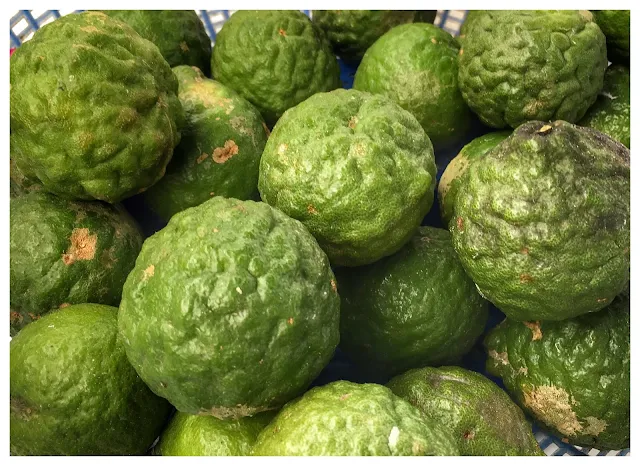The sizzle of oil, the puffing up of dough and the appetising aroma in the air. The stuff of what one expects walking around markets, this one in SS2, a suburb of Petaling Jaya, part of the developed housing and commercial areas outside Kuala Lumpur. It was morning and the stalls had been set up after a few days of holiday over the Lunar New Year. Those simple looking and yet tasty Eu Char Kwai, in Cantonese or the Yao Tiao in Mandarin, for oil fried crullers, at once simmering in the large wok and then soon enough, laid out to rest and settle to crunchy. These look like breadsticks but have a different flavour.
The gluten has to be well formed and rested over night in the dough making these Chinese styled crullers.
The crullers are good for dunking into coffee and congee, as you please. The stall holders wear aprons and masks. The time spent in front of cooking oil can have its disadvantages - and so does standing outdoors, in front of vehicular traffic swirl. There are so many forms of the fried snacks, some with fruits like Cempadak inside, others with banana slices and some others still with flat cuts of sweet potato. The Cempadak fruit is sweeter than the standard jack fruit, although but share similar characteristics on the outside.
The fruit is also compared to breadfruit and mainly sourced from south-east Asia and southern India. How does one know when the sticky yellow fruit inside is ready to eat? If we think like a monkey, which does devour such delicacies in the wild, use our nose and sense of smell. Rich in fibre, Riboflavins,Vitamins C and A plus potassium, this fruit is used in making cakes, ice cream flavours, desserts and eaten as they are, fresh.
Ang Jiu Mee Suah, a niche soup of thin strip longevity hand pulled noodles, swirling around bite sized reddish coloured chicken parts, is a Fuzhou tradition. The colour comes from the glutinous red wine utilised to marinade the meat. Ginger and sesame oil are used to lift up the flavours.
I was fortunate to sample this in suburban Petaling Jaya, at the Wing How Coffee Shop in Taman Suria, Sungei Way. This is not an easy find for me, as I have hardly come across this dish. Ideally, organic chicken is preferred when preparing this comfort food. One can eat with cut chillies in a light soy sauce, as in common practice in most of south-east Asia.
Kaffir lime fruits look stone-like hardy, are not as inviting as the Kumquats and the related plant is more valued for its aromatic leaves than its fruit. The contents of this fruit help to sharpen a stir fry, add more zest to a seafood curry and also add fibre. They are also known as the Makrut Lime or the Papeda in Mauritius. They are common in tropical regions of Asia, have unique shaped double leaves and can be available in areas of south-east Asian migrants in Western countries.
In Thailand, the leaves are used in making the iconic Tom Yum soup, where the sharp citrus like flavours add a zest to the soup. The rinds of the fruit are added to make a thicker Thai curry paste. Away from the kitchen, the juice of this lime is also used as cleansers for clothing and for hair wash.
Bean curd wraps over fish ball rolls are best dipped in chilli sauce, provide finger licking food and yet can be eaten anytime (the Fu Zhou version pictured below). The type of specific fish that is grounded or shredded to mix into the balls can affect its ultimate taste. The wraps are often eaten as snacks by themselves and in Yum Cha sessions. The Cantonese, Hokkiens, Teochews and Hakkas do include this in their culinary menu.
The original Nasi Lemak, when it was more of a take away snack on the run, is wrapped with banana leaves, which add to the flavour. No meats, no veg! The approach of this dish is stimulating the palate with a minimum of ingredients, while adopting the maximum impact of a well done Sambal. The one I had in KL recently had anchovies soaked in the paste, a wholesome half hard boiled egg, peanuts and a well braised squid slice.
Reflecting the best of Thai street food, it is not so much of the ingredients but how they are mixed together and presented. In addition, it is also the interplay of texture and contrast in flavours - chilli hot, sour, savoury. This rice based creation has now moved on to upmarket restaurants which seem to want to add curry more than Sambal, meat more than crunchies and size more than yum.
Often served with cucumber slices, to offset the chilli's fiery heat, this dish has a critical component - in how you prepare the coconut milk flavoured steamed rice, often uplifted in aroma by using a tied up leaf of the Pandanus or screw pine plant. The whole thing comes out as a wholesome and appetising combination. There are also variations in recipe if you make the Straits Chinese version - where lemon grass can be an option, and deep fried chicken also offered as an accompaniement.
The Sambal is usually made with tamarind juice, shrimp paste, small prawns, chilli paste, red onion, shallots and garlic. The proof of such a good condiment is in the taste, texture and balance of ingredients.











































